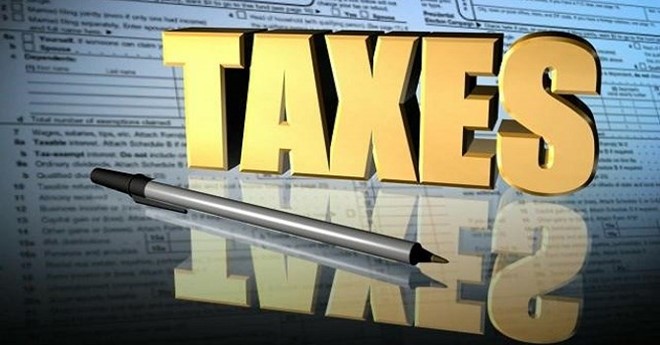
Thống kê
| 1882835 | |
| Số người đang online | 1 |
| Số truy cập hôm nay | 246 |
| Số truy cập tháng này | 57976 |
Quảng cáo
The Finance Ministry said the 10 contract jobs, eat 4 Council Tax

|
The Ministry of Finance has ideas about businesses do pay taxes 10 4 copper contract is reflected in the press last week.
In the past week, several newspapers have reflected issues Vietnam now have to spend nearly 40% of the profits to taxpayers is too large, exceeding the tolerance of affecting business competitiveness and is one of the some reasons why Vietnam now dissolved, stop activity increases.
According to the Ministry of Finance in the new text of the evening was broadcast 28/2, with the question "How are 10 contracts, taxes" eat "4 Council" led to interpretations ratio of tax revenue / profits of the business in Vietnam at a high level is not correct, need to be analyzed, in order to separate out exactly how.
As for taxes, fees in the financial sector, the state mobilized amounts from businesses and individuals in society to serve the financing of activities of the state and nature of indirect refund.
To compare the correlation between countries, often using criteria ratio% between raised from taxes, fees calculated on the total gross domestic product (GDP).
Compared with other countries, the construction, calculation of revenue in Vietnam is special to note when comparing the level of budget mobilization of Vietnam with other countries.
Specifically as follows: Currently, the budget revenues from taxes, fees according to data from many countries and international organizations are synthetic and often just announced the budget revenues of the central government budget by the system of these countries have the independence between budget levels.
Meanwhile, the budget system of Vietnam includes four levels: central, provincial, district and commune levels. So the revenue budget was announced, the annual public revenues always include all four levels of the budget in the fiscal system (ie including both central and local).
In terms of revenue targets balancing the state budget, according to the statistical methods of the Vietnam budget revenues, the revenues from crude oil, from land use rights, from the sale of state-owned houses are also common on revenue, of which oil revenues are to be classified in tax revenues as revenues from other taxes.
However, the review of the nature of this revenue is not anonymous account from the economic mobilization.
In many countries, these revenues are classified in group revenues "from which" (revenues from the sale of national resources) and not be included in budget revenues as mobilizing account from taxes and charges.
For example, the case of China, a source of encouragement budget shows revenues from crude oil, obtained from the land, proceeds from the sale of assets owned by the state, such as in Vietnam.
Therefore, to ensure the accuracy and reflect the fact that the comparison of the proportion of the state budget revenues of GDP in Vietnam with other countries should be based on uniform criteria and the same nature.
According to statistics, the proportion of total state budget revenues to GDP of Vietnam period 2011-2015 is about 23.3%, while the proportion of encouragement from taxes, fees of about 20.9%.
While the proportion of total state budget revenues to GDP of some countries in the region such as Thailand for the period 2011-2015 is 23%, Indonesia is 16.6%, 23.4% Laos, Malaysia is 24.5 %, 19.5% of India's ...
If only compare mobilization own tax rate, charged on GDP, with the peculiarities of the structure and method of collection of revenue accounted for the difference between Vietnam and other countries such as the above analysis, the sources budget figures in Vietnam used to compare countries should exclude revenues have different properties, revenues have essentially "revenue from capital" and not nature encouragement from operations economy.
Specifically, the calculation for the period of 5 years from 2011 to 2015: Percentage budget encouragement from taxes, fees (including revenue from crude oil) in about 20.9% of GDP Vietnam.
Excluding oil revenues, the percentage of the budget from tax mobilization, overall cost in Vietnam is about 17.2% of GDP; if they continue to exclude revenues from land use fees, the rate budget encouragement from taxes, fees in Vietnam at around 15.6%.
Corporate income tax (CIT), during the 10 years from 1999 to 2009, the income tax rate was adjusted down from 32% in 1999, 28% from 2004 and 25% since 2009 in accordance with strategy and roadmap for tax reform.
Ordinary tax rate from 22% in 2014 and down 20% from 01/01/2016 and preferential tax rate of 10% and 17%.
If compared with the average rate of the 83 countries in the world is 27%; compared with some countries in the region have common tax rate of 30% as the Philippines, Thailand; China 25%, Malaysia 25%, the ordinary tax rate of Vietnam is rated as low, the Finance Ministry said.
|
Liên kết website
Hỗ trợ trực tuyến
-
 Liên hệ ngay.Email:ĐT: (08) 6682 3335 - Fax: (08) 6256 2218
Liên hệ ngay.Email:ĐT: (08) 6682 3335 - Fax: (08) 6256 2218
Ngày giờ hiện tại
13/9/2025
clock




